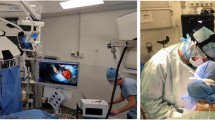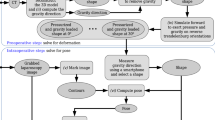Abstract
Each year in Europe 50,000 new liver cancer cases are diagnosed for which hepatic surgery combined to chemotherapy is the most common treatment. In particular the number of laparoscopic liver surgeries has increased significantly over the past years. This type of minimally invasive procedure which presents many benefits for the patient is challenging for the surgeons due to the limited field of view. Recently new augmented reality techniques which merge preoperative data and intraoperative images and permit to visualize internal structures have been proposed to help surgeons during this type of surgery. One of the difficulties is to align preoperative data with the intraoperative images. We propose in this paper a semi-automatic approach for solving the ill-posed problem of initial alignment for Augmented Reality systems during liver surgery. Our registration method relies on anatomical landmarks extracted from both the laparoscopic images and three-dimensional model, using an image-based soft-tissue reconstruction technique and an atlas-based approach, respectively. The registration evolves automatically from a quasi-rigid to a non-rigid registration. Furthermore, the surface-driven deformation is induced in the volume via a patient specific biomechanical model. The experiments conducted on both synthetic and in vivo data show promising results with a registration error of 2 mm when dealing with a visible surface of 30% of the whole liver.
Access this chapter
Tax calculation will be finalised at checkout
Purchases are for personal use only
Preview
Unable to display preview. Download preview PDF.
Similar content being viewed by others
References
Nicolau, S., Soler, L., Mutter, D., Marescaux, J.: Augmented reality in laparoscopic surgical oncology. Surgical Oncology 20(3), 189–201 (2011)
Puerto-Souza, G., Mariottini, G.: Toward long-term and accurate augmented-reality display for minimally-invasive surgery. In: ICRA 2013, pp. 5384–5389 (2013)
Yip, M.C., Lowe, D.G., Salcudean, S.E., Rohling, R., Nguan, C.Y.: Tissue tracking and registration for image-guided surgery. IEEE Trans. Med. Imaging 31(11), 2169–2182 (2012)
Haouchine, N., et al.: Image-guided simulation of heterogeneous tissue deformation for augmented reality during hepatic surgery. In: ISMAR (2013)
Su, L.M., et al.: Augmented reality during robot-assisted laparoscopic partial nephrectomy: Toward real-time 3d-ct to stereoscopic video registration. Urology 73(4), 896–900 (2009)
Bano, J., et al.: Simulation of pneumoperitoneum for laparoscopic surgery planning. In: Ayache, N., Delingette, H., Golland, P., Mori, K. (eds.) MICCAI 2012, Part I. LNCS, vol. 7510, pp. 91–98. Springer, Heidelberg (2012)
Oktay, O., Zhang, L., Mansi, T., Mountney, P., Mewes, P., Nicolau, S., Soler, L., Chefd’hotel, C.: Biomechanically driven registration of pre- to intra-operative 3D images for laparoscopic surgery. In: Mori, K., Sakuma, I., Sato, Y., Barillot, C., Navab, N. (eds.) MICCAI 2013, Part II. LNCS, vol. 8150, pp. 1–9. Springer, Heidelberg (2013)
Dagon, B., Baur, C., Bettschart, V.: A framework for intraoperative update of 3d deformable models in liver surgery. In: 30th Annual International Conference of the IEEE Engineering in Medicine and Biology Society, EMBS 2008, pp. 3235–3238. IEEE (2008)
Clements, L.W., et al.: Robust surface registration using salient anatomical features for image-guided liver surgery: Algorithm and validation. Medical Physics 35(6) (2008)
Ferrant, M., et al.: Registration of 3-d intraoperative mr images of the brain using a finite-element biomechanical model. IEEE Trans. on Medical Imaging 20(12), 1384–1397 (2001)
Bardinet, E., et al.: A three-dimensional histological atlas of the human basal ganglia. atlas deformation strategy and evaluation in deep brain stimulation for parkinson disease. J. of Neurosurgery 110(2) (2009)
Yushkevich, P.A., Piven, J., Cody Hazlett, H., Gimpel Smith, R., Ho, S., Gee, J.C., Gerig, G.: User-guided 3D active contour segmentation of anatomical structures: Significantly improved efficiency and reliability. Neuroimage 31(3), 1116–1128 (2006)
Plantefève, R., Peterlik, I., Courtecuisse, H., Trivisonne, R., Radoux, J.-P., Cotin, S.: Atlas-based transfer of boundary conditions for biomechanical simulation. In: Golland, P., Hata, N., Barillot, C., Hornegger, J., Howe, R. (eds.) MICCAI 2014, Part II. LNCS, vol. 8674, pp. 33–40. Springer, Heidelberg (2014)
Marchesseau, S., Heimann, T., Chatelin, S., Willinger, R., Delingette, H.: Multiplicative jacobian energy decomposition method for fast porous visco-hyperelastic soft tissue model. In: Jiang, T., Navab, N., Pluim, J.P.W., Viergever, M.A. (eds.) MICCAI 2010, Part I. LNCS, vol. 6361, pp. 235–242. Springer, Heidelberg (2010)
Felippa, C., Haugen, B.: A unified formulation of small-strain corotational finite elements: I. theory. Comput. Meth. Appl. Mech. Eng. 194(21) (2005)
Yeh, W.C., et al.: Elastic modulus measurements of human liver and correlation with pathology. Ultrasound in Medicine & Biology (2002)
Author information
Authors and Affiliations
Editor information
Editors and Affiliations
Rights and permissions
Copyright information
© 2014 Springer International Publishing Switzerland
About this paper
Cite this paper
Plantefève, R., Haouchine, N., Radoux, JP., Cotin, S. (2014). Automatic Alignment of Pre and Intraoperative Data Using Anatomical Landmarks for Augmented Laparoscopic Liver Surgery. In: Bello, F., Cotin, S. (eds) Biomedical Simulation. ISBMS 2014. Lecture Notes in Computer Science, vol 8789. Springer, Cham. https://doi.org/10.1007/978-3-319-12057-7_7
Download citation
DOI: https://doi.org/10.1007/978-3-319-12057-7_7
Publisher Name: Springer, Cham
Print ISBN: 978-3-319-12056-0
Online ISBN: 978-3-319-12057-7
eBook Packages: Computer ScienceComputer Science (R0)




